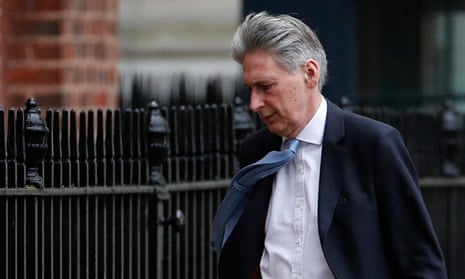Philip Hammond must find an extra £5bn in this year’s Whitehall spending review to reverse planned cuts and meet his claim of ending austerity, a leading thinktank has revealed.
The Institute for Fiscal Studies told the chancellor that funds pledged in last year’s budget to boost NHS spending, defence and international aid failed to safeguard local councils and some of the worst-hit government departments from further shortfalls.
The thinktank said a minimum of £2.2bn would be needed to freeze all budgets and protect them from inflation, but ministers would need to find an extra £5bn to allow departments to maintain services in line with the UK’s rising population.
Hammond claimed that “austerity is coming to an end” in last year’s autumn budget after better-than-expected tax revenues and a relaxation of his deficit rules allowed him to promise a £30bn boost in public spending by 2024.
Figures from the IFS showing that to match his promise, Hammond needed to find more funds will come as a blow to the Treasury as it prepares the chancellor’s spring statement due on 13 March.
A sharp slowdown in economic growth in recent months is expected force the Treasury’s independent forecaster, the Office for Budget Responsibility, to downgrade government tax income and increase expenditure over the next five years.
Brexit uncertainty over the coming weeks is likely to make the situation worse, while the population continues to expand at around 1m people every four years, heaping further pressure on Hammond to find extra funds to meet his promise of ending the austerity programme which began almost a decade ago.
Ben Zaranko, a research economist at the IFS, said provisional plans set out in the autumn 2018 budget revealed cuts in day-to-day spending on public services outside health, defence and overseas aid of about 0.4% a year in real terms and 0.9% per capita.
The budget squeeze will be added to cuts of up to 40% in the Ministry of Justice, the Department for Environment, Food and Rural Affairs and local government since 2010.
Zaranko said the next round of cuts would be at a much slower pace than seen over the last decade “but would by no means represent an ‘end to austerity’ ”.
Richard Watts, the leader of Islington council and chair of the Local Government Association’s resources board, said: “If the government fails to adequately fund local government in the spending review then there is a real risk to the future financial viability of some services and councils.
“Councils were at the front of the queue when austerity started so local services should be at the front of the queue if it is coming to an end.”
John McDonnell, the shadow chancellor, said government claims that austerity was over were unravelling.
“The evidence is mounting that, despite Theresa May’s rhetoric, austerity is not over. Unless Philip Hammond, at the very least, finds another £5bn at the spring statement, departments will be planning for yet more cuts next year.
“Nine years of brutal Tory austerity have wounded our public services and the whole country which relies on them. The chancellor has promised a ‘Brexit bonus’ and any failure to deliver it at the spring statement will be yet more evidence of the Tories’ failure to negotiate a Brexit deal that benefits jobs and the economy.”
